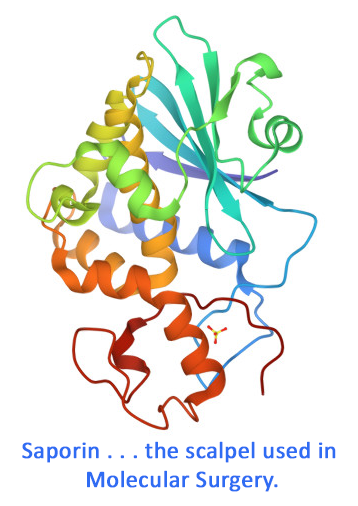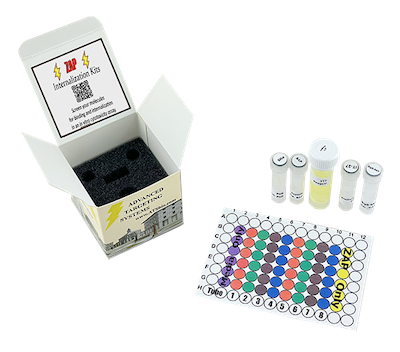Hum-ZAP uses your primary human monoclonal IgG antibody to target and eliminate cells that recognize your primary antibody. This secondary conjugate uses the secondary antibody (affinity-purified goat anti-human IgG) to “piggyback” onto YOUR human primary antibody. Hum-ZAP can be utilized for screening human IgG antibodies for internalization and/or their suitability to make potent immunotoxins. When the in vitro results confirm the desired specificity, it is recommended that you order a custom conjugation of your antibody to saporin.
Hum-ZAP is a chemical conjugate of affinity-purified goat anti-human IgG and the ribosome-inactivating protein, saporin. It uses your human primary antibody to target and eliminate cells. This secondary conjugate is used to evaluate the potential of a primary antibody to internalize.
Hum-ZAP is available individually (Cat. #IT-22) or as a kit (Cat. #KIT-22) which includes Hum-ZAP, Saporin (Cat. #PR-01), Goat IgG-SAP (Cat. #IT-19) and reagents for developing a cytotoxicity assay.
Other ZAP Conjugates:
Need another ZAP Conjugate for your target? Check here for other species & targets including in vivo and in vitro options.
keywords: Human Antibody, Human Primary, Human Monoclonal, Anti-Human IgG, Screening, ADC, Antibody Drug Conjugate, in vitro, secondary
Synchronous intracellular delivery of EGFR-targeted antibody-drug conjugates by p38-mediated non-canonical endocytosis
Takahashi JI, Nakamura S, Onuma I, Zhou Y, Yokoyama S, Sakurai H (2022) Synchronous intracellular delivery of EGFR-targeted antibody-drug conjugates by p38-mediated non-canonical endocytosis. Sci Rep 12(1):11561. doi: 10.1038/s41598-022-15838-8 PMID: 35798841
Objective: The binding of cetuximab to EGFR suppresses ligand-induced signaling events. The authors demonstrate that synchronous non-canonical EGFR endocytosis can increase the efficacy of EGFR-targeting ADCs.
Summary: Epidermal growth factor (EGFR) has been a popular target in the treatment of cancer via monoclonal antibodies, specifically cetuximab and panitumumab. They have been applied to antibody-drug conjugates (ADCs) and their clinical efficacy had been demonstrated, but this efficacy has also been limited by acquired resistance via secondary mutations or the activation of bypass pathways. To overcome these limiting factors, the authors investigated if non-canonical clathrin-mediated endocytosis (CME) of EGFR induced the internalization of membrane-bound EGFR-targeted mAbs. Their results show that tumor necrosis factor-alpha strongly induces endocytosis of the cetuximab-EGFR complex via the p38 phosphorylation of EGFR and that Hum-ZAP, a secondary antibody conjugated to saporin, will also undergo internalization with the complex and enhance anti-proliferative activity.
Related Products: Hum-ZAP (Cat. #IT-22)
Saporin as a commercial reagent: its uses and unexpected impacts in the biological sciences-tools from the plant kingdom
Ancheta LR, Shramm PA, Bouajram R, Higgins D, Lappi DA (2022) Saporin as a commercial reagent: its uses and unexpected impacts in the biological sciences-tools from the plant kingdom. Toxins (Basel) 14(3):184. doi: 10.3390/toxins14030184 PMID: 35324681
Summary: Saporin is a ribosome-inactivating protein that can cause inhibition of protein synthesis and causes cell death when delivered inside a cell. Development of commercial Saporin results in a technology termed ‘molecular surgery’, with Saporin as the scalpel. Its low toxicity (it has no efficient method of cell entry) and sturdy structure make Saporin a safe and simple molecule for many purposes. The most popular applications use experimental molecules that deliver Saporin via an add-on targeting molecule. These add-ons come in several forms: peptides, protein ligands, antibodies, even DNA fragments that mimic cell-binding ligands. Cells that do not express the targeted cell surface marker will not be affected. This review will highlight some newer efforts and discuss significant and unexpected impacts on science that molecular surgery has yielded over the last almost four decades. There are remarkable changes in fields such as the Neurosciences with models for Alzheimer’s Disease and epilepsy, and game-changing effects in the study of pain and itch. Many other uses are also discussed to record the wide-reaching impact of Saporin in research and drug development.
Read complete article.
Conservation of oncofetal antigens on human embryonic stem cells enables discovery of monoclonal antibodies against cancer
Tan HL, Yong C, Tan BZ, Fong WJ, Padmanabhan J, Chin A, Ding V, Lau A, Zheng L, Bi X, Yang Y, Choo A (2018) Conservation of oncofetal antigens on human embryonic stem cells enables discovery of monoclonal antibodies against cancer. Sci Rep 8:11608. doi: 10.1038/s41598-018-30070-z
Objective: To identify and characterize an antibody raised using human embryonic stem cells with potential as a cancer therapeutic.
Summary: Antibody A19 not only binds to undifferentiated hESCs by flow cytometry, it also reacts with ovarian and breast cancer cell lines with low or no binding to normal cells.
Usage: in vitro - Number of viable cells treated showed a decrease in cell number (Hum-ZAP mixed with A19; Streptavidin-ZAP mixed with biotinylated A19). To determine if there were off-target effects, Hum-ZAP and chA19 were incubated with a non-binding cell line OVCAR10; no apparent cytotoxicity was observed. invivo - 5 x 106 SKOV3 cells were implanted s.c. in NUDE mice and Biotinylated A19-Streptavidin-ZAP (ADC), administered ip. The controls were free Saporin and naked A19. By the end of 10 weeks, mice administered with the ADC saw a 60% reduction in tumor size compared to control groups.
Related Products: Hum-ZAP (Cat. #IT-22), Streptavidin-ZAP (Cat. #IT-27), Saporin (Cat. #PR-01)
Targeting of embryonic annexin A2 expressed on ovarian and breast cancer by the novel monoclonal antibody 2448
Cua S, Tan HL, Fong WJ, Chin A, Lau A, Ding V, Song Z, Yang Y, Choo A (2018) Targeting of embryonic annexin A2 expressed on ovarian and breast cancer by the novel monoclonal antibody 2448. Oncotarget 9:13206-13221. doi: 10.18632/oncotarget.24152
Objective: To develop mAbs to potentially target oncofetal antigens and be repurposed for antibody or antibody drug conjugate (ADC) therapy.
Summary: The novel IgG1, 2448, was shown to target a unique glycosylated surface epitope on ANXA2. As a possible therapeutic candidate for ovarian and breast cancer, 2448 demonstrated anti-tumor activity via two independent mechanisms of action.
Usage: Cells were seeded in 96-well plates at 1000 or 2000 cells/well. Primary antibody, 2448 or ch2448 (10 μg/mL) was pre-mixed with appropriate secondary saporin conjugate, Mab-ZAP or Hum-ZAP. The most significant decreases in cell viability (20% to 60%) were observed against the epithelial IGROV1 and MCF7 cell lines. ATS created a Custom ADC by direct conjugation of saporin to ch2448 (ch2448-SAP). As a control, an isotype chimeric IgG was also conjugated to saporin (IgG-SAP). Compared to using secondary saporin conjugates, ch2448-SAP induced and increase of 20–30% cytotoxicity.)
Related Products: Mab-ZAP (Cat. #IT-04), Hum-ZAP (Cat. #IT-22), Custom Conjugates
Evaluate Potential Targeting Molecules.
Kohls M (2006) Evaluate Potential Targeting Molecules. Nature Methods
Summary: Targeted toxins -- targeting agents conjugated to saporin -- are widely used to eliminate specific cell populations both in vitro and in vivo. For these molecules to be effective, it is vital that the targeting component of the conjugate specifically binds the cells of interest. A secondary conjugate, Streptavidin-ZAP, has been created by attaching the toxin saporin to streptavidin. The user can combine primary biotinylated material with Streptavidin-ZAP to quickly and economically screen potential targeting molecules for internalization and specificity. Once the appropriate targeting molecule is identified, a direct conjugation with saporin can be performed.
Related Products: Streptavidin-ZAP (Cat. #IT-27)
Read the article.
browse all references for this product | back to top



Reviews
There are no reviews yet.